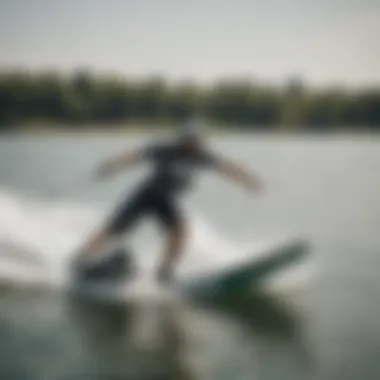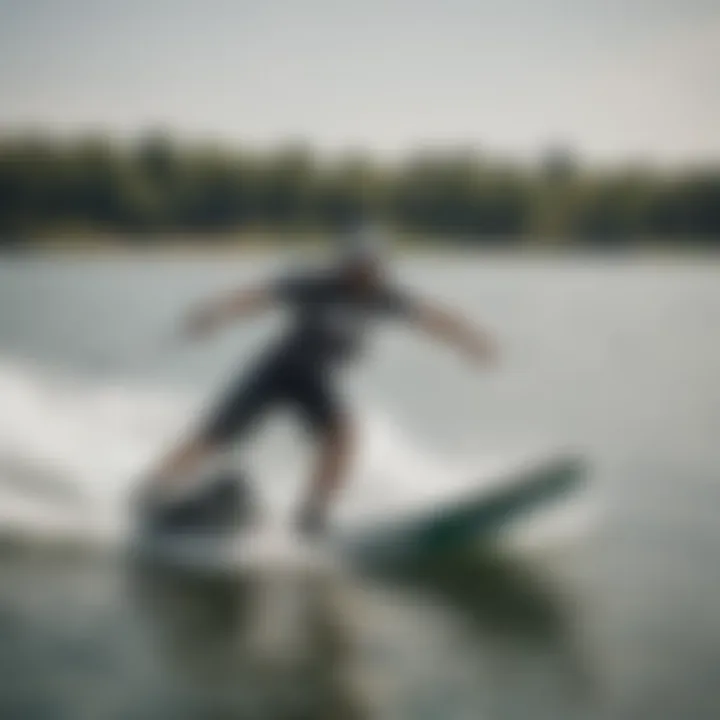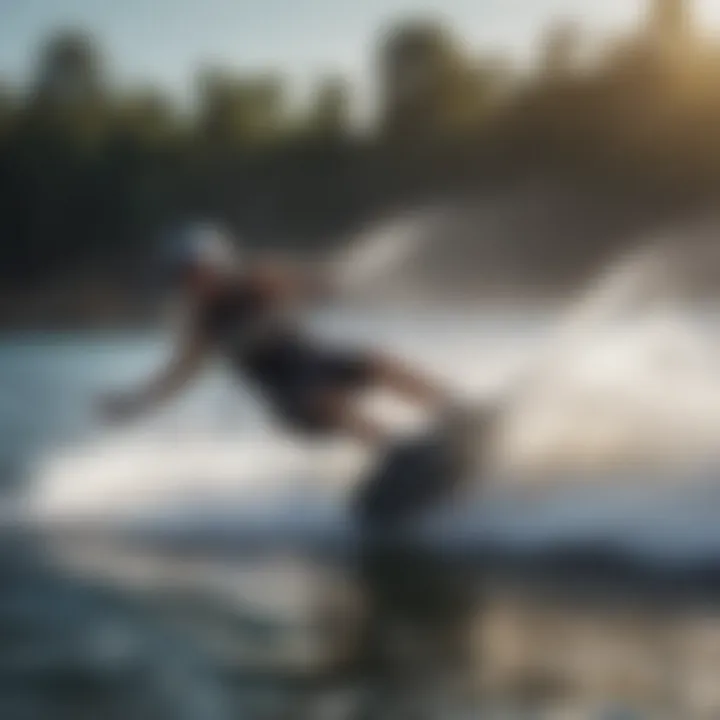Choosing Wakeboard Length According to Rider Weight


Intro
Wakeboarding is more than just a thrilling outdoor sport; it's an intricate dance between the rider and the water. Selecting the right gear, particularly the wakeboard's length, becomes essential for maximizing performance and ensuring safety. Understanding how a wakeboard's length relates to a rider's weight establishes a solid foundation for anyone looking to enhance their skills on the water. The interplay between board size, the rider's unique attributes, and external conditions can greatly influence ride quality.
As we dive into this topic, the conversation will cover the significant aspects one should consider — from the mechanics of board sizing to evaluating personal riding style and skill level. Misunderstandings abound when it comes to wakeboard lengths; many people believe a heavier rider always needs a longer board, which isn't always the case. This article aims to clear the air surrounding these common misconceptions, ensure that new and seasoned enthusiasts can make informed decisions about their equipment, and highlight the importance of personal testing.
To kick things off, we'll explore important techniques and skills needed for a successful ride, catering to both beginners and experienced riders alike, before delving into safety measures and gear recommendations.
Understanding Wakeboarding
Wakeboarding, often seen as a blend of surfing, snowboarding, and skiing, has evolved into a popular water sport that attracts thrill-seekers and casual riders alike. Understanding the nuances of wakeboarding is essential, especially when considering the critical factor of board length in relation to a rider's weight. This article aims to explore the intricate details of this relationship, highlighting how it influences performance, safety, and the overall experience on the water.
History of Wakeboarding
The roots of wakeboarding can be traced back to the late 1980s, when enthusiasts began experimenting with boards on the waves created by motorboats. It draws elements from different sports, notably surfing and snowboarding. The original boards were often modified surfboards or plywood slabs, not designed specifically for this purpose. As technology evolved, dedicated wakeboards began to make their appearance, featuring enhanced designs for improved performance. This history offers a glimpse into how the sport has adapted and transformed, emphasizing the need for the right equipment today.
Basic Techniques
To fully engage in wakeboarding, understanding the basic techniques is crucial. Riders must learn how to balance their weight on the board, which directly correlates to the length of the board being used. Key techniques include:
- Getting Up: The initial rise out of the water can be tricky and requires practice. Using a board that matches your weight helps achieve better balance and control.
- Carving: This involves turning the board to navigate the wakes effectively. The board length may affect how tight these turns can be executed.
- Jumping: As riders progress, jumps and tricks become a significant part of wakeboarding. The right board length can offer the needed stability when landing.
Equipment Overview
In wakeboarding, equipment is not just a matter of preference; it’s a science. The relationship between a rider's weight and their choice of board length cannot be overstated. Here are some vital equipment components:
- Boards: The length is critical. Longer boards often provide more surface area, easing navigation for heavier riders.
- Bindings: These attach the rider to the board and need to fit snugly without restricting movement. Proper sizing ensures better control.
- Ropes: The rope length impacts the angle at which the rider is pulled, influencing both comfort and performance. Selecting the right length complements the board choice further.
"Getting the right equipment is half the battle in wakeboarding. Each piece plays a role in how well you ride."
As water sport enthusiasts explore wakeboarding, it’s clear that understanding the fundamentals sets the stage for deeper involvement. Ultimately, mastering the sport requires insight into both weight and equipment to achieve the best possible ride.
Importance of Board Length
Selecting the right wakeboard length is not just a matter of personal preference; it plays a crucial role in how a rider performs on the water. The relationship between board length and rider weight intertwines, influencing performance, comfort, and ultimately, safety. When the board length is appropriate for the rider's weight, it sets the stage for a more enjoyable experience on the water.
Impact on Performance
In the world of wakeboarding, performance is king. The length of the wakeboard can make a distinguishable difference in three key areas: speed, stability, and agility.
Speed
Speed is what gets the adrenaline pumping. A board that is too long for a lightweight rider can create drag, making it harder to gain that exhilarating velocity. On the other hand, a shorter board allows for quicker acceleration, which is often favored by riders looking for thrills. The key here is that an optimal speed facilitates jumps and tricks, allowing the rider to maximize their aerial capabilities. Considerable speed is a benefit for riders who enjoy performing stunts or simply chasing the wake. However, one must remember that while shorter boards yield increased speed, they might compromise stability.
Stability
Stability comes into play when navigating rough waters. A longer board usually affords a more stable ride, essential for maintaining balance, especially for heavier riders. This characteristic is appealing to those who are just starting out or anyone keen on mastering their craft. With a stable base, riders are less likely to wipe out as they can maintain steadiness even when encountering waves or turbulence. Nevertheless, it’s important to note that gains in stability can mean slower maneuverability for experienced riders accustomed to making sharp turns and quick adjustments.
Agility
Agility reflects a rider's ability to maneuver swiftly and change direction. Shorter boards excel here, providing quick responses to shifts in weight and navigation adjustments. This has its perks, particularly in competitive scenarios where rapid changes can make or break a run. Agility can be beneficial for riders looking to perform intricate tricks and acrobatic movements on the water. But with this agility comes a slight risk; less stable boards can lead to unintentional wipeouts, especially for those who may not yet have mastered balance.
Safety Considerations
Safety cannot be an afterthought when it comes to determining board length. Proper sizing can significantly affect a rider's balance and control on the water.
Balance
Balance is the cornerstone of wakeboarding. An incorrectly sized board can throw off a rider's equilibrium, resulting in falls or accidents. A board that fits well helps distribute weight evenly, fostering greater control. Riders can respond quicker to changes in water conditions, promoting a sustained sense of safety. Therefore, achieving a proper balance is paramount for enjoying the sport without the shadow of danger.


Control
Control gives riders the confidence they need. When the board length matches their weight, riders find it easier to maintain direction and speed. A well-fitted board allows for more precise handling, making it easier to execute tricks or navigate turns. Riders are less likely to feel overwhelmed or insecure while controlling the board in various water conditions. The true advantage here is that better control translates to enhanced enjoyment of the activity, a key factor for both amateurs and veterans alike.
Selecting Wakeboard Length
Selecting the appropriate wakeboard length is essential for optimizing performance and enjoyment on the water. It directly impacts several factors such as control, speed, and agility while you ride. Understanding how to choose the right length based on your weight is crucial in ensuring a balanced experience that aligns with your specific riding style and skill level. Moreover, with an array of choices available today, knowing the right parameters can help evade the common pitfalls many choose to overlook.
General Guidelines
Weight Ranges
When it comes to selecting a wakeboard, understanding weight ranges is fundamental. Typically, manufacturers categorize boards into weight ranges, which help you match your body weight to the ideal board length. These ranges provide a baseline that simplifies the decision-making process.
For instance, a wakeboard marked for riders weighing between 140 and 180 pounds generally ranges from 134 to 139 centimeters in length. This helps maintain an equilibrium between buoyancy and maneuverability. A board that is too short might hinder your ability to glide smoothly, whereas a board too long could feel sluggish. This makes hitting the right weight range crucial for progressing in the sport.
"Choosing the right weight range for your board maximizes your ride's efficiency and satisfaction."
Board Length Categories
Board length categories are interconnected with weight ranges but offer an additional layer of specificity. These categories might classify boards as short, medium, or long. For example, short boards (usually around 130-140 cm) are suited for tricks and agile maneuvers; medium boards (140-145 cm) offer a balance of speed and stability; and long boards (145 cm and above) are often favored for beginners or heavier riders as they provide extra support and smoother rides in choppy waters.
Each category holds its own unique advantages and disadvantages. If you're serious about slashing through waves and pulling off aerial tricks, a shorter board may be beneficial despite the struggles in stability. But if you prioritize comfort and ease in choppy conditions, leaning towards a longer board is often the way to go.
Factors Influencing Choice
Rider's Weight
Rider's weight is arguably one of the most significant factors affecting wakeboard length. The more weight you bring to the equation, the longer your board should typically be to support your ride effectively. Boards are usually designed with the intent to balance rider weight with buoyancy. A heavier rider on a shorter board may find that they sink too low in the water, resulting in drag and difficulty maintaining speed.
The weight-specific approach not only gives a solid baseline but also ensures that riders can optimize their performance. However, riders should also readjust their board choice based on individual comfort and riding habits.
Riding Style
Riding style plays a pivotal role when it comes to selecting board lengths. A rider who predominantly enjoys carving and tricks will benefit from a board that allows sharp turns and quick movements. On the other hand, those who prefer a more laid-back ride or enjoy cruising might opt for a more forgiving board that ensures ease of use.
As such, understanding your riding style is essential. If you favor jumps and tricks, a shorter board is your friend. But if stability and comfort are what you're after, leaning towards longer options would serve you better.
Skill Level
Skill level is the third cog in this complex mechanism. Beginners often find themselves more comfortable on longer boards. This is simply because longer boards provide stability, making it easier to get accustomed to the water dynamics. As riders become more versed in their skills, transitioning to a shorter board enhances maneuverability but can also increase the challenge.
Recognizing your skill level allows for more informed decision-making. As you progress, you can gradually experiment with different lengths while learning how to effectively manage the board's behavior beneath your feet. This ensures a smoother transition rather than abruptly switching to a shorter board and struggling unnecessarily.
Rider Weight and Wakeboard Length Correlation
Selecting the right length of a wakeboard based on the rider’s weight is essential for enhancing both performance and safety on the water. A direct correlation exists between these two factors, influencing how the board behaves while riding, making it a crucial topic for anyone passionate about wakeboarding.
One significant element to consider is that the right board length facilitates better balance and control. If a board is too short for a rider's weight, it can lead to instability, making tricks more challenging. Conversely, a board that's too long can be cumbersome and unresponsive, limiting agility. Understanding this relationship can dramatically improve the riders' experiences, resulting in more enjoyable sessions and reduced risk of injury.
In this section, we break down the ideal weight to length ratios that can guide both novice and seasoned riders. Additionally, we'll delve into adjustments that are crucial for different skill levels, ensuring that your time on the water is as productive and fun as possible.
Ideal Weight to Length Ratios
Lightweight Riders
When it comes to lightweight riders, a key aspect to keep in mind is the need for precision in board length. For those weighing less than 140 pounds, boards typically range from 130 to 134 cm. This particular length allows lightweight riders to achieve a balance between speed and control. They benefit from increased maneuverability, which is critical when learning tricks or navigating different water conditions.
A notable characteristic of lightweight riders is their agility. They're generally able to maneuver their boards with ease, allowing for quick turns and flips. This makes them more inclined to engage in trick riding, where moments of higher speed and balance are essential. However, lightweight riders might find it challenging in choppier waters. A board that’s a tad too short might cause them to bounce unnaturally on waves, diminishing their control.


In short, the unique feature of a board suited for lightweight individuals promotes a balance of speed and stability but requires careful consideration to avoid a lack of control in harsh conditions.
Heavyweight Riders
On the other hand, heavyweight riders, defined as those above 180 pounds, have a different set of requirements. For them, longer boards, ranging from 135 to 144 cm, are generally more beneficial. This characteristic alone underscores why selecting the correct board length plays such a critical role. With greater weight comes the need for a broader surface area to maintain stability, especially when catching larger wakes.
Heavyweight riders often experience another dimension of wakeboarding, where power translates to a different ride feel. The unique feature of longer boards provides increased support on the water, allowing for smoother landings and more powerful edge control. However, one consideration is that heavier individuals may potentially lose out on maneuverability, which can affect performance during trick sessions. Thus, while they gain stability, they might need to adapt their riding style to accommodate a less agile board.
Adjustments for Skill Level
Beginner Considerations
For those at the start of their wakeboarding journey, selecting the right board length also requires additional focus on their skill level. Beginners should ideally choose boards that are slightly longer within the recommended range. This added length offers a larger surface area, thus enhancing their ability to maintain balance.
The key trait of beginner considerations is their often less consistent riding experience. As such, a longer board can significantly aid in making their initial attempts less daunting. While it might seem counterintuitive, a beginner on a board that’s too short may struggle more with stability, especially when turning or trying to get up from a fall.
A longer board also allows for easier progression, making it feasible for beginners to build confidence on the water before transitioning to shorter boards as their skills improve.
Advanced Techniques
When riders progress to advanced techniques, their board choices must evolve as well. Advanced riders often prefer shorter boards, often around 134 to 139 cm, to maximize responses and facilitate rotation in tricks. The maneuverability afforded by these boards allows for complex moves that require quick direction changes
The pivotal element for advanced techniques is the need for responsiveness. Skilled wakeboarders seek agility to execute spins, flips, and jumps, all of which are hindered by longer boards. However, this transition may require a readjustment to the rider's weight distribution and control techniques, as shorter boards present a narrower sweet spot for balance. Finding this balance can make or break an advanced riders' experience.
As you get into the nuances of selecting the right board, consider not just your weight, but your skill level as well. It’s not just about having fun; it's about doing it safely and effectively.
Common Misconceptions
When it comes to wakeboarding, one of the notable hurdles every enthusiast faces is navigating through common misconceptions surrounding board length and rider weight. Having the right information is crucial, especially considering that improper choices can hinder performance or even lead to safety issues. Recognizing these misconceptions not only helps beginners make informed choices but also allows seasoned riders to enhance their experience on the water. A clear grasp of these myths can foster better understanding and prevent costly mistakes.
Shorter Boards for Light Riders
A widespread belief in the wakeboarding community is that lighter riders should always opt for shorter boards. On the surface, this appears logical, as one might assume that a lighter weight necessitates a smaller surface area to effectively create lift and maneuverability. However, this kind of blanket statement can be misleading.
For instance, while a shorter board can offer quick turns and a snappy feel for lighter riders, they might find that these boards compromise stability, especially when facing choppy waters or large wakes. Therefore, it’s essential to recognize that lighter riders might benefit from a slightly longer board than one might predict, depending on the riding style and conditions.
- Performance Impact: Shorter boards might lead to more difficulty staying on edge and maintaining control at higher speeds.
- Rider Preferences: Not every light rider desires agility over stability; some prefer a steadier ride, especially during longer sessions.
Longer Boards for Heavy Riders
Conversely, many believe the opposite is true for heavier riders: they need longer boards to accommodate their weight and achieve a balanced ride. Here again, the conventional wisdom doesn't always hit the mark. While it’s true that a longer board can help distribute weight and provide better flotation, this is only part of the picture.
Heavy riders may find that choosing a board that is excessively long can lead to unwieldiness, making tricks and quick turns much more challenging. Instead, the ideal scenario might be choosing a board that is just the right length, balancing surface area while not sacrificing maneuverability.
- Board Dynamics: Longer boards can be sluggish in turns, which could affect overall performance and rider enjoyment.
- Rider Skill Level: An advanced rider may prefer a shorter board for improved agility, whereas a beginner might feel more comfortable learning on a slightly longer board for stability.
Testing Board Lengths
Determining the perfect wakeboard length is not a straightforward one-size-fits-all approach. The process involves a bit of science and a whole lot of experimentation. Testing different board lengths is crucial for ensuring both performance and enjoyment on the water. Individuals will find that each board behaves differently based on a multitude of factors, making it essential to take this step seriously in the quest for the right fit.
The benefits of testing lengths can’t be overstated. Riders can experience first-hand how their weight influences the board’s behavior, such as buoyancy and responsiveness. It's not just about finding something that looks good or feels comfortable in the store; it’s about catching that perfect wave and maintaining control while shredding through the water. Furthermore, different water conditions might also contribute to the performance of a specific board length. Therefore, practicing with trial boards across various scenarios can lead to significant gains in proficiency.
"The right board length can elevate your experience from mediocre to exhilarating."
Trial and Error Method
Finding the Right Fit
One of the most pragmatic methods for determining the board length is the trial-and-error approach. What this means is pretty simple: get out there and try different lengths. Every water sport enthusiast, regardless of their level, has likely found themselves in a world of confusion when choosing the “ideal” length for their abilities. The process of finding the right fit becomes a journey rather than merely a decision.


Finding the right fit is characterized by direct engagement with the sport. This hands-on method is not just beneficial; it’s often considered essential. Why? Because the feeling of riding a board with proper length versus one that doesn’t suit your weight is like night and day. A board that’s too short can lead to instability, while one that’s too long might hinder both control and agility. In short, it’s about creating a relationship between rider and board that feels seamless.
That said, testing out various lengths can have both advantages and disadvantages. While an initial trial might help pinpoint a particular size, it can also lead to confusion if too many options inundate a rider. However, this experience can offer valuable insights, laying the groundwork for more informed choices in the future.
Seeking Expert Advice
Instructor Guidance
While many riders find delight in discovering their preferences independently, seeking expert advice can smooth out the learning curve significantly. Guidance from a qualified instructor can illuminate the path to understanding board lengths much clearer. Their knowledge and experience allow them to offer tailored recommendations based on a rider's weight, skill level, and riding style.
Instructor guidance stands out mainly because of its personal touch. It’s not just about throwing out numbers or generic suggestions; experts can assess the rider while they practice and provide real-time feedback. This help can tremendously enhance the learning experience. An advantage here is that the rider can avoid the common pitfalls associated with incorrect sizing from the get-go. However, one disadvantage could be that lesser-known instructors might not have enough experience to give sound advice. Thus, it's essential to choose wisely.
Community Feedback
Another valuable avenue for determining the best wakeboard length is to tap into community feedback. Engaging with fellow wakeboarders can offer insights on what works and what doesn't through shared experiences. Often, this collective pool of knowledge proves rich with information.
The key characteristic of community feedback is its diversity. From local enthusiasts to seasoned veterans, everyone has a different take based on their preferences and riding experiences. This variety can be exceptionally helpful for someone who might be overwhelmed when starting their journey in wakeboarding. Community feedback often highlights the practical challenges that individual riders faced, which can directly relate to board length choices.
On the flip side, the drawback is that opinions can be subjective and may depend on personal preferences, which might not be universally beneficial. Therefore, while community feedback provides an excellent basis for consideration, it should be combined with personal testing to arrive at the best decision.
Environmental Considerations
When selecting the appropriate wakeboard length, it’s crucial to consider environmental factors that can significantly impact your riding experience. Both water conditions and the wake produced by the boat can create varying challenges and opportunities for riders. Understanding these elements helps ensure that you not only enjoy your time on the water but also optimize your performance and safety.
Water Conditions
Calm vs. Choppy Water
The calm water presents its own set of advantages. When the surface is smooth like glass, it offers excellent traction, allowing riders to perform more technical tricks with a higher probability of success. You'll notice that riders who prefer to maintain speed while trying out new maneuvers thrive in these conditions. The smoothness of calm water supports stability, reducing the likelihood of jarring impacts, making it easier for beginners to find their footing and for seasoned riders to perfect their craft.
On the flip side, choppy water poses unique challenges, often testing a rider's skills to navigate uneven surfaces. Waves can either come from natural wind patterns or from the boat itself, creating a dynamic environment for wakeboarding. This uneven surface can lead to more exciting ride sensations but also increases the risk of falls, especially for those on shorter boards that can get tossed around more easily.
Key Characteristics:
- Calm Water: Smooth, serene, ideal for learning and performing tricks.
- Choppy Water: Dynamic, requires more skill, great for creating more thrilling experiences.
Given these points, calm water is generally regarded as a more friendly choice, particularly for newbies, as they can focus on mastering technique without the added hurdle of big chop. In contrast, seasoned riders often relish the challenge of choppy waters for the added thrill, honing their skills under less forgiving conditions.
Wake Size and Shape
The wake size and shape, dictated largely by the boat and its speed, can vary drastically, impacting the rider's ability to perform tricks and navigate the water effectively. Generally, a larger wake can provide a more substantial ramp for riders to utilize, increasing the potential for aerial maneuvers. However, the same large wakes can be harder to handle, especially for riders on smaller boards, which may struggle to maintain stability.
When considering length and style of your wakeboard in relation to wake size, a few points warrant attention:
- Type of Wake Produced: A steep wake, for instance, will require a longer board to ensure adequate stability and comfort when landing jumps.
- Rider Weight: Heavier riders may find shorter boards less effective on larger wakes, emphasizing the need for a carefully matched length.
Environmental considerations are often overlooked but are quintessential in fine-tuning both equipment choice and riding technique. Maintaining a awareness of conditions can empower riders to adapt, leading to safer and more enjoyable experiences on the water.
Ending
Summarizing the journey through wakeboard length selection based on rider weight offers valuable insights into making the right choice. Selecting an appropriate wakeboard length is not a trivial decision. It encompasses various elements such as performance, comfort, and safety. When riders align their board with their weight, they achieve a better overall experience on the water. A correctly sized board not only enhances maneuverability but also ensures that riders can maintain stability during tricks or sharp turns.
Recap of Key Insights
Throughout this article, the essence of determining the correct wakeboard length has emerged through several fundamental points:
- Weight and Board Length Correlation: As established, there is a clear relationship between the rider's weight and the length of the board. Riding a board that is too short or too long can affect control and enjoyment on the water.
- Environmental Factors: Conditions like water choppiness and wake size play a crucial role in choosing board length. For instance, heavier riders might prefer a longer board in choppy waters to offset instability.
- Skill Level Adjustments: Beginners often benefit from different length considerations compared to seasoned riders. Longer boards may provide extra surface area for novices, aiding balance and control, while experienced wakeboarders might opt for shorter boards for agility.
Future Considerations in Wakeboard Selection
As the sport evolves, so does the technology and methodology behind selecting the perfect wakeboard. Here are some future points to keep in mind:
- Innovative Materials: The development of new materials could alter how boards feel in the water, affecting the rider's experience.
- Heightened Customization: Companies are increasingly looking towards customizable options tailored to individual rider weight and style.
- Increased Education: Awareness campaigns focused on correct board sizing and environmental awareness will likely grow, as more riders seek education on performance.
In a sport where personalization is key, being informed about your choices will lead to more enjoyable sessions on the water. Remember, learning and adjusting don’t stop after picking a board; it’s an ongoing process of tuning in to your individual needs and experiences.















